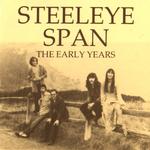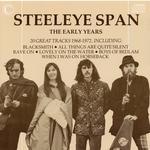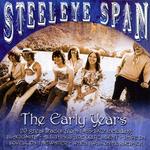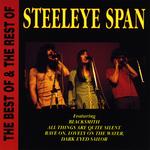> Steeleye Span > Records > The Early Years / The Best of & the Rest of
Steeleye Span: The Early Years / The Best of & the Rest of
 |
The Early Years Connoisseur VSOP LP/MC 132 (2 LP/MC, UK, March 1989) |
 |
 |
The Best of & the Rest of Steeleye Span Action Replay CDAR 1012 (CD, UK, 1990) |
 |
The The Early Years CD misses the last four tracks of the double LP; the playing order of the remaining tracks 1-20 is the same. The CD originally had similar artwork (top right) but the 2001 reissue has a new picture (bottom left) similar to the drawing on the budget CD A Stack of Steeleye Span and is as faulty as this. In their early years, Steeleye just didn’t have a drummer.
The Action Replay CD is a cut-down budget reissue with the title The Best of & the Rest of Steeleye Span. It has only the first fourteen tracks of the LP, i.e. the tracks up to My Johnny Was a Shoemaker. By the way, the similarly titled CD The Best of & the Rest of Folk Masters is a reissue of Rave On.
Tracks
Side 1
- Blacksmith (Roud 816) (3.42)
- Prince Charlie Stuart (Roud 3099; Henry H533) (4.17)
- Marrowbones (Roud 183; Laws Q2; G/D 2:318; Henry H174; TYG 6) (4.28)
- Reels: Dowd’s Favourite / £10 Float / The Morning Dew (3.46)
- Westron Wynde (Roud V18833) (0.27)
- Dark-Eyed Sailor (Roud 265; Laws N35; G/D 5:1037; Henry H232) (5.56)
Side 2
- All Things Are Quite Silent (Roud 2532) (2.39)
- Rave On (2.10)
- Lovely on the Water (Roud 1539) (5.21)
- Wee Weaver (Roud 3378) (2.40)
- The Brisk Young Butcher (Roud 167; G/D 7:1466) (2.51)
- Boys of Bedlam (4.20)
Side 3
- The Blacksmith (Roud 816) (4.47)
- My Johnny Was a Shoemaker (Roud 1388; G/D 8:1848) (1.13)
- Jigs: Paddy Clancy’s Jig / Willie Clancy’s Fancy (3.11)
- When I Was on Horseback (Roud 2; Laws Q26) (6.13)
- Cold, Haily, Windy Night (Roud 135; G/D 4:778) (4.38)
- The Ploughboy and the Cockney (Roud 1688) (3.35)
Side 4
- One Night As I Lay on My Bed (Roud 672) (3.32)
- Horn of the Hunter (Roud 1859) (3.01)
- Copshawholme Fair (Roud 9139) (2.35)
- Female Drummer (Roud 226; G/D 1:182; Henry H497) (4.05)
- Skewball (Roud 456; Laws Q22) (3.31)
- The Lark in the Morning (Roud 151) (4.33)
#1, 6, 7, 14, 19 and 21 were originally released on
Hark! The Village Wait
#2, 9, 12, 13, 17, 22 and 24 were originally released on
Please to See the King
#8 was originally released as a single
#3, 4, 10, 15, 16 and 23 were originally released on
Ten Man Mop or Mr Reservoir Butler Rides Again
#11 was originally released on
Tim Hart and Maddy Prior: Folk Songs of Old England Vol. 1
#20 was originally released on
Tim Hart and Maddy Prior: Folk Songs of Old England Vol. 2
#5 and 18 were originally released on
Tim Hart and Maddy Prior: Summer Solstice
Sleeve Notes
Steeleye Span’s brilliant settings of traditional folk in contemporary arrangements were undoubtedly one of the major musical accomplishments of the late sixties. Ever since the beginning of the commercial entertainment industry our tradition of popular folk culture has gradually been eroded. The Americans seemed to have little trouble in updating their Old Time music into widely acceptable country music or the blues into R&B and subsequently Rock and Roll, while the enthusiastic guardians of our own folk heritage had it all safely preserved in sterile libraries or dreary song clubs.
For many of my generation our first brush with folk music was tripping round the school hall to country dance records or having plummy voiced renditions of folk songs thrust at us in music lessons, little wonder that the pop industry won our hearts with all of its glitter and glamour. However, the sixties were turbulent years for youth and the new radical movements began to reject anything that smacked of commercialism, including most pop music. Instead many of us were attracted to music that you could make for yourself, songs that seemed more relevant to the way in which we were thinking. For a while it seemed as if every town had at least one folk or blues club, but here the music was still dominated by a sort of mid-atlantic style. At this time Ashley Hutchings was playing bass with Fairport Convention, a band who had already started to blend rock with folk but still drawing mainly on American and contemporary sources. Intrigued by the folk tradition he sought out Terry Woods who had already earned considerable respect with the legendary Sweeney’s Men, a band which had developed an exciting and innovative style remaining purely acoustic. Meanwhile Tim Hart and Maddy Prior had been inhabiting traditional folk clubs where the songs were treated with such veneration that the addition of even purely acoustic accompaniment was rather frowned upon. An attitude which they perceived would probably cause traditional folk to become even more of a minority interest.
Together with Terry Woods and his wife Gay, Ashley made contact with Tim and Maddy and the line was completed for what was to be one of the most exciting musical experiments for years. It was a potent combination, the artists involved had all arrived at the same place but from different backgrounds and the impact of their music sent shock waves in all directions. The self styled guardians of our folk heritage threw up their hands in horror wondering how their delicate specimens would cope with this brutal electric assault. The contemporary music scene also pricked up its ears. What was this new sound that was unmistakeably modern but had an old and slightly mysterious feel to it? These were the days when Tolkien was becoming a cult figure, romantic rusticism was becoming fashionable and this strange, almost medieval sound wrapped in a familiar cloak of electric arrangement was immediately appealing.
After the release of the first album Martin Carthy and Peter Knight took over from Gay and Terry and the band continued to increase its following, two albums later and they had truly consolidated their position. The early seventies were boom years for the folk movement, folk clubs were doing better than ever. Morris Dance teams proliferated and hundreds of Steeleye Span soundalikes started playing for ceilidhs across the country. Hopefully it is now accepted that change and adaptability are fundamental to the continuing success of traditional culture and that the endeavours of Steeleye Span have not damaged our musical heritage but helped to ensure its survival.
Simon Evans

